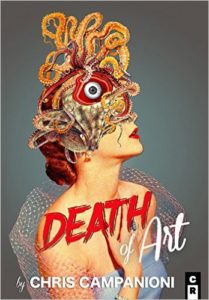 Chris Campanioni writes in the chapter entitled Notes Written In Margins, “I am interested in the intersection between all the public interaction we have in private & the paradoxes which exist because of this divide in logic & space.”
Chris Campanioni writes in the chapter entitled Notes Written In Margins, “I am interested in the intersection between all the public interaction we have in private & the paradoxes which exist because of this divide in logic & space.”
This one sentence perfectly summarizes Campanioni’s collection, Death of Art. I say “collection”, but what it actually is is a memoir. It is not a traditional memoir, however, as Campanioni writes about his life through poetry, experimental prose, vignettes, text messages, and some combination of all of the above. His focus is exactly that intersection between public/private interactions. In this century with reality television and social media constantly blurring the lines between what is real and what is produced, Campanioni’s writing appeals to readers today. He understands this relationship readers and viewers have with our reality television-saturated lives and his place in it as a teacher and a writer.
Throughout the text, Campanioni references popular culture from Beverly Hills, 90210 to the 1990s hit film, While You Were Sleeping, and shares his personal experiences with them through stories of his own, reminding us that we are all a part of a nesting egg of audience – participant – audience – participant. We are as much a part of Campanioni’s life merely by reading his words as he is a part of ours, and experiences are shared, privately as well as publicly.
Authentic experience has been replaced by fetishized experience; existence becomes object. And actual experience is surpassed by talking about it. But not just talking about it, re-distributing it to the whole world, stamped and packaged in a Facebook or Instagram post. A new skill learned on LinkedIn.
We are selling ourselves back to ourselves.
Award-winning author Chris Campanioni may, for better or worse, be the voice of our generation in which the internet is our stomping ground and making eye contact with our friends and family is a rare treat if someone forgets to charge their phone or leaves it in another room. Like many of us, he understands the necessity of the internet as well as harbors a cynicism and healthy distrust of it.
Every moment that exists exists to be recorded, dramatized, and sold to the public; how do we know what real drama is when it happens to us? And when confronted with something tragic or beautiful, something real, do we still have the language to express our feelings?
A wonderful collection, timely and relevant. It’s possible this will be a tad too timely, and after a few years have passed and social media morphs into some other new app, and someday in the future if Facebook no longer exists, readers may have a hard time accessing Campanioni’s point. Though looking again at the title of the memoir, Death of Art, it appears that’s exactly the point he wanted to make.
Death of Art
By Chris Campanioni
C&R Press
ISBN 978-1-936196-60-9
